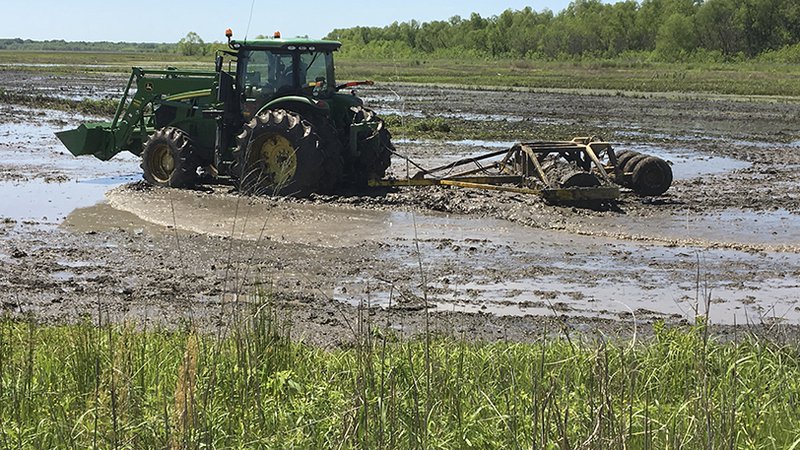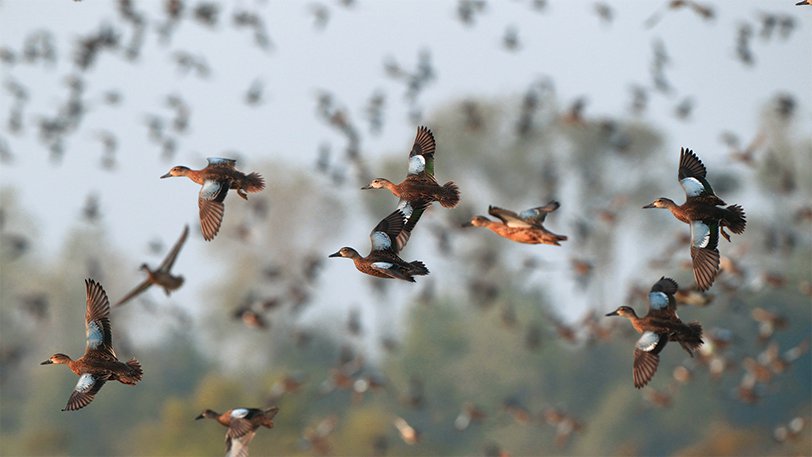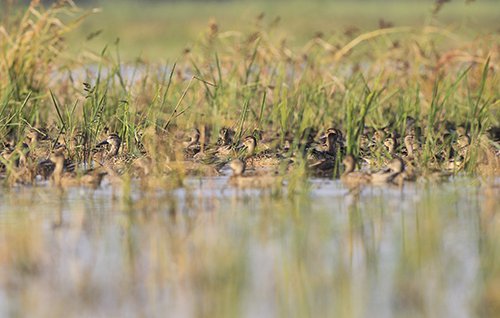Frog Bayou WMA rolling out the red carpet for ducks
BY agfc
ON 05-09-2018

May 9, 2018
ALMA – For most Arkansans, thoughts of duck season have been stowed alongside the waders and decoys, but work for the next year in the wetlands has already begun at Frog Bayou Wildlife Management Area near Alma.
Since mid-March, Arkansas Game and Fish Commission biologists have drawn water slowly off the WMA and pulverized the remaining vegetation with a special tractor and cleated roller to lay the groundwork for vast amounts of seed-producing wetland plants.
“The roller helps all the old vegetation decompose, which puts nutrients back in the soil, and stirs up all the seeds underneath in the seed bank,” said Brian Infield, wildlife management biologist for the AGFC in Fort Smith. “Barnyard grass, smartweed, sprangletop and many other plants that produce food for ducks thrive in the mudflat conditions left after the roller is done.”
Infield, an AGFC biologist with a bachelor’s degree from Arkansas Tech University and 27 years of experience managing natural resources, says the cleated roller is similar to a light-duty disk used in conventional row-crop farming, but enables biologists to get a jump start when preparing plots of native food.

“Disking requires the ground to be drained before you can get to work, but rolling can be done with 3 to 6 inches of water still standing on the area,” Infield says. “Very few conventional farmers in the area have even been able to do any tillage because of the amount of rainfall we’ve had this year.”
Not only does rolling enable biologists to start preparing WMAs earlier, it lets them make modifications if the plants don’t respond well during the summer.
“We monitor the areas that have been rolled and if the areas are not producing the native vegetation to our satisfaction we still have time to plant some millet or spray to remove competition from plants that don’t produce the food for ducks. We already have a few places we know we will go back and disk, then plant with a cover crop. Flushing with water also will encourage more native plants.”
Infield says the response from waterfowl to these “moist soil units” on the managed portions of the WMA has been so good, many more will be added to a recently acquired expansion to the WMA once permits have been acquired and units can be planned and developed properly.
In addition to the ability to manage more acres of food-producing plants, moist-soil units offers many benefits for ducks and duck hunters lacking with conventional crops.

AGFC Wetlands Program Coordinator Buck Jackson says moist soil unit management has the same attraction to ducks as a good buffet has to people.
“Diversity is the key to any wildlife management when it comes to food and cover,” Jackson said. “You wouldn’t go to a buffet every night if they only served baked chicken. You need other components for your health.”
Jackson is a certified wildlife biologist with a bachelor’s degree in wildlife management, who has worked both planning and working from the tractor on moist soil units for 20 years, the last 10 of which was for the AGFC. He says moist soil units not only offer seeds rivaling many cultivated stands of crops, they also offer protein not found in corn, rice and other agricultural products.
“You have the vegetables in the wild millets (called barnyard grass) and smartweed, plus you have many more invertebrates and insects that provide the meat to their diet,” Jackson said. “Protein is the jet fuel for waterfowl. Ducks will burn muscle mass on the migration, and put it right back on with bugs and other protein sources.”
Jackson, who introduced the cleated roller to AGFC wetland management in 2009, says maintenance of native vegetation is much less time-consuming for biologists than commercial crops would be, which is extremely important with the thousands of acres needed to maintain during the year in addition to other wildlife management duties, such as monitoring for chronic wasting disease, increasing wildlife habitat on upland areas and maintaining roads, trails and other public accesses throughout the state.
“These native plants are already resistant to many of the pests commercial crops must be protected from with additional labor and expensive chemicals,” Jackson said. “I’ve seen people tear out smartweed that’s genetically built to resist armyworms to plant something that could get wiped out by them. They just put their ace in the hole for duck season at risk for no reason.”
Jackson and Infield also point out that native vegetation can be manipulated after the growing season and still be legal to hunt ducks over, unlike conventional crops. According to federal waterfowl regulations, planted crops cannot be manipulated to increase forage on the ground where you will hunt ducks; the same law does not apply to native vegetation.
“Before teal season, we can mow some meandering strips through the moist soil grasses then let it flood to create a hemi-marsh,” Infield said. “The seed heads will be knocked down and scattered for ducks, and hunters will still be allowed to hunt it without fear of it being a baited field.”
The food produced in these moist soil units also lasts much longer than commercial crops, which means ducks, geese and many shorebirds will use the areas long after beans, corn and rice have rotted away.
“When we started rolling this March, many ducks and shorebirds were still using the area on their way back to breeding grounds up north,” Infield said. “Once those seeds and bugs were stirred up from that roller, you should have seen all the teal, mallards and gadwalls that came in to take advantage of the food. That’s next year’s ducks and the foundation for future seasons.”
Check out a video from Frog Bayou WMA that shows a great side benefit to moist soil units
Recent News
Subscribe to Our Weekly Newsletter E-mails
Don’t miss another issue. Sign up now to receive the AGFC Wildlife Weekly Newsletter in your mailbox every Wednesday afternoon (Waterfowl Reports are published weekly during waterfowl season and periodically outside the season). Fishing Reports arrive on Thursdays. Fill in the following fields and hit submit. Thanks, and welcome!


